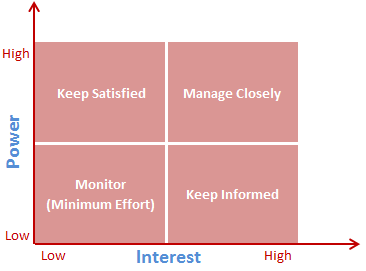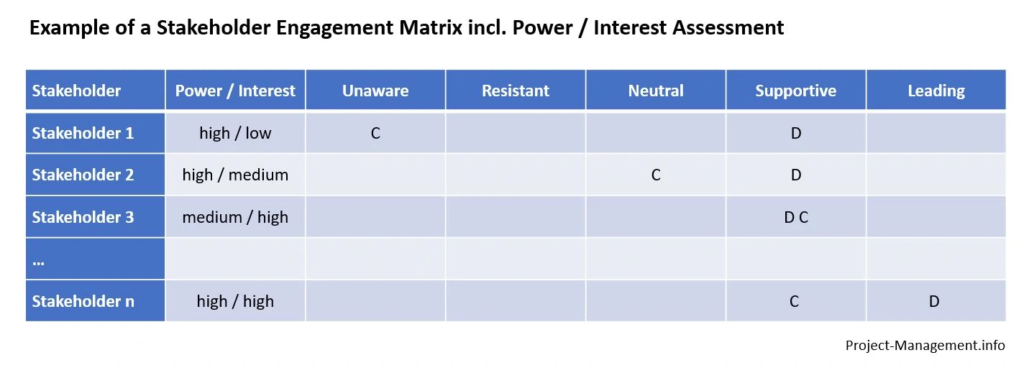
A Power Interest Grid is a matrix used for categorizing or prioritizing stakeholders during a project to allow them to be effectively managed. Stakeholders are plotted on the grid in relation to the Power (Y-axis) & Interest (X-axis) they have in respect of the project. Charting the relationship between different stakeholders is the best way to spot potential sources of disagreement. The grid helps you understand the relative interests of each stakeholder so that you can respond appropriately to conflicting goals.
Pre-requisite: Identify all stakeholders involved in the project.
Understanding the Power Interest Grid grid will enable you to tailor your communication and engagement strategies, ensuring the right stakeholders are involved at the right time.
- Defining the Power Interest Grid: The Power Interest Grid is a visual representation of stakeholders based on their power and level of interest in a project or initiative. Power refers to the ability of a stakeholder to influence decisions and outcomes, while interest signifies their engagement and concern. By plotting stakeholders on a grid with power on the x-axis and interest on the y-axis, we can identify four distinct quadrants: High Power High Interest, High Power Low Interest, Low Power High Interest, and Low Power Low Interest.
- Prioritizing Stakeholder Engagement: The Power Interest Grid serves as a strategic tool to prioritize stakeholder engagement efforts. Stakeholders in the High Power High-Interest quadrant require close attention as they have significant influence and a vested interest in the project’s success. These key stakeholders should be actively involved, informed, and their concerns addressed. Stakeholders in the other quadrants have varying levels of importance and can be engaged accordingly, ensuring resources and efforts are allocated appropriately.
- Tailoring Communication and Engagement Strategies: Each quadrant of the Power Interest Grid requires a different approach for effective communication and engagement. High Power Low-Interest stakeholders, such as executives or regulatory bodies, may need periodic updates and briefings. Low Power High-Interest stakeholders, such as end-users or community groups, may require more involvement and active participation to gather feedback and ensure their needs are met. Low Power Low-Interest stakeholders may need minimal engagement, while still being kept informed to maintain their support.
- Adapting and Revisiting the Power Interest Grid: Stakeholders’ power and interest levels can change throughout the project lifecycle, necessitating a regular reassessment of the Power Interest Grid. As the project progresses, stakeholders may shift from one quadrant to another, requiring adjustments in engagement strategies. By continuously evaluating and adapting the grid, you can ensure your stakeholder management remains effective and responsive to evolving dynamics.
Power Interest Grid – Four Quadrants
The following questions can help you identify the interests of stakeholders:

- What do stakeholders expect from the project and how do they benefit?
- Are there any conflicting interests that the stakeholder may have with the project?
- How committed is the stakeholder to the project? Is he/she willing to commit tangible resources?
- Are there relationship conflicts between stakeholders that can hinder the project?
- Who influences their opinions generally, and who influences their opinion of you? Do some of these influencers, therefore, become important stakeholders in their own right?
Power – How much influence do they have over your project/idea? Can they help to move it forward or could they stop it in its tracks?
Interest – How much interest do they have in your project/idea? Will it be beneficial to them for example?
The Power Interest Grid is split into Four Quadrants
- High Power – High interest (Manage Closely): these stakeholders are decision-makers and have the most significant impact on the project’s success hence you must closely manage their expectations. For example – The sponsor, Company management.
- High Power – Low Interest (Keep Satisfied): these are the stakeholder needed to be kept in the loop, these stakeholders need to be kept satisfied even though they aren’t interested because they yield power. These types of stakeholders should be dealt with cautiously as well since they may use their power in a not desired way in the project if they become unsatisfied. For example – Functional Managers, Government regulators.
- Low Power – High interest (Keep Informed): keep these people adequately informed, and talk to them to ensure no major issues arise. These people can often be very helpful with the detail of your project. For example – Support Functions like HR, Finance, and the local community.
- Low Power – Low interest (Monitor): monitor these people but don’t bore them with excessive communication. For example – Subject Matter Experts, and Potential customers.
After using the Power Interest Grid, you can then progress on developing appropriate stakeholder management strategies. You can also use the RASCI acronym (Responsible, Accountable, Support, Consult and Inform) to define each stakeholder’s involvement in the project which can also help effectively manage the project.
TIP: Use a SWOT diagram to help you analyze how different individuals feed into your project’s strengths and weaknesses or pose opportunities and threats.
Stakeholder Engagement Assessment Matrix
The Stakeholder Engagement Assessment Matrix is a way of analyzing and portraying the level and direction of stakeholder engagement. It consists of several rows, each of them representing one stakeholder (or a group of homogenous stakeholders, if applicable). The columns indicate the level of engagement. There are the following classifications:
- Unaware – does not know about the project or its benefits and other impacts.
- Resistant – aware of the project and its impacts, but resistant to the change.
- Neutral – aware of the project, not resistant or supportive.
- Supportive – aware of the project, and supports the change and potential impacts.
- Leading – aware of the project and potential impacts, and actively ensuring its success.

Example of Stakeholder Engagement Assessment Matrix
Let’s take an example of a project that involves the creation of a software package for a client. The project has the following stakeholders:
- Chief financial officer (sponsor),
- Chief executive officer,
- Chief information officer,
- Head of Accounting,
- Head of regulatory reporting,
- Users of the new systems,
- IT architects,
- Internal Audit,
- External Auditors, etc.
The desired level (“D”) of engagement is then incorporated into the stakeholder engagement matrix. However, a “D” is typically not applicable to the “unaware” or “resistant” columns.
| Stakeholder | Unaware | Resistant | Neutral | Supportive | Leading |
| Chief financial officer (sponsor) | D | ||||
| Chief executive officer | D | ||||
| Chief information officer | D | ||||
| Head of Accounting | D | ||||
| Head of regulatory reporting | D | ||||
| Users of the new system | D | ||||
| IT architects | D | ||||
| Internal Audit | D | ||||
| External Auditors | D |
When monitoring the actual stakeholder engagement, the project manager adds the observed current level (“C”) of engagement for each stakeholder:
| Stakeholder | Unaware | Resistant | Neutral | Supportive | Leading |
| Chief financial officer (sponsor) | C D | ||||
| Chief executive officer | C | D | |||
| Chief information officer | C D | ||||
| Head of Accounting | C D | ||||
| Head of regulatory reporting | C | D | |||
| Users of the new system | C | D | |||
| IT architects | C | D | |||
| Internal Audit | C D | ||||
| External Auditors | C | D |
Summary
Identifying and measuring the interest and influence levels of stakeholders is critical for stakeholder prioritization. Constructing the stakeholder map ensures that you have considered the full range of people and organizations that need to be included. Analyzing stakeholders, grouping them based on their posture, and understanding their concerns will also help target your communications and engagement strategy.
